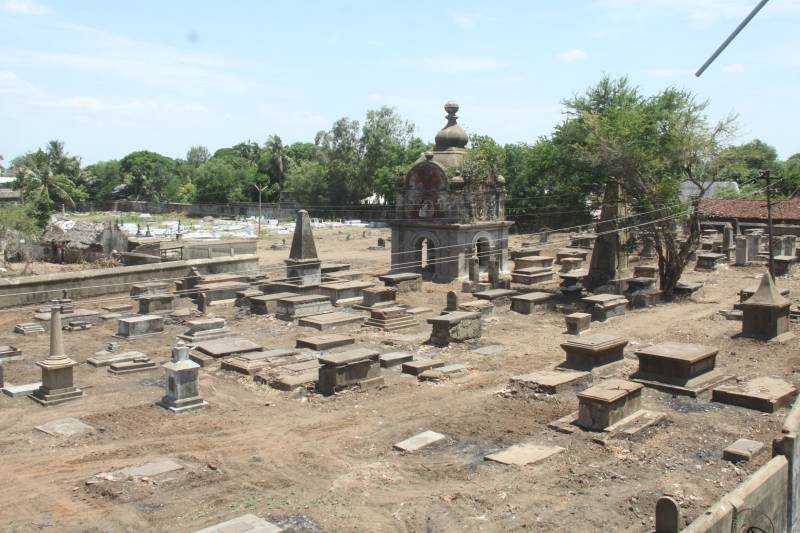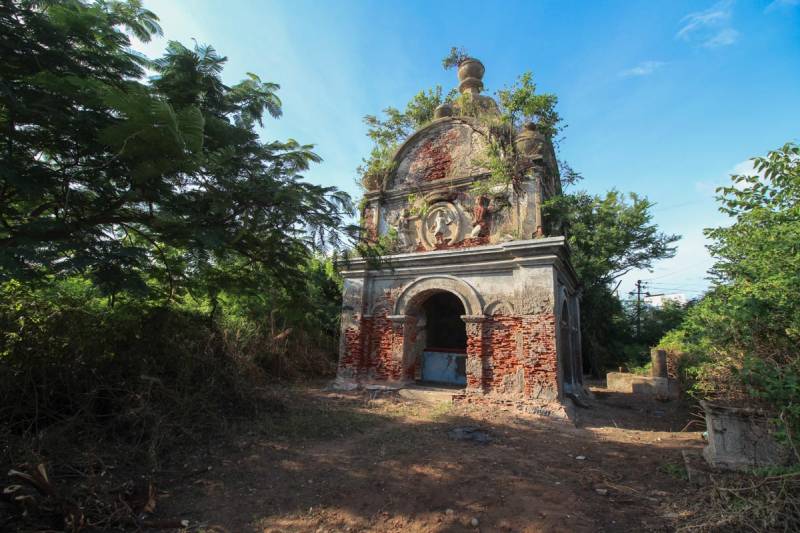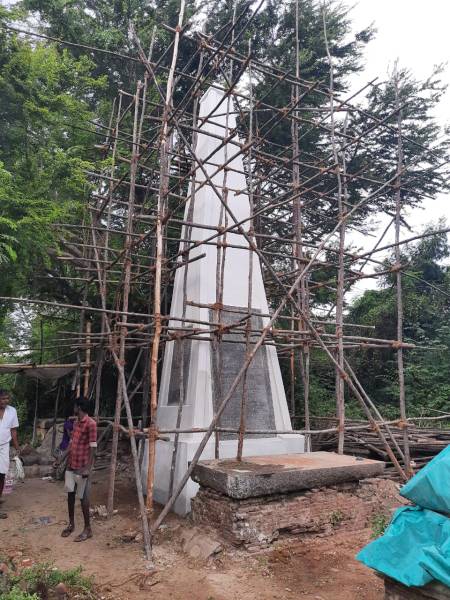Nagapattinam - Short introduction to Karikop
Not long after the Dutch conquered the fort at Nagapattinam from the Portuguese in 1665, a new cemetery was put into use, further inland. The cemetery is known today as "karikop", a corruption of the Dutch word "kerkhof", meaning churchyard.
The old entrance gate still exists, but has been bricked up. On the gate the text: Beati Morientes in Domini (Blessed are those who die in the Lord). Much of the wall around the cemetery still exists, but has disappeared on the side where the cemetery was later expanded. The new part of the cemetery is still in use, while the original part is mostly overgrown with dence shrubs.
The oldest grave monument on Karikop is for Ioannes Kruyf, who died in 1664. The youngest grave monument with a Dutch text is for Eleteria Alexandersz., who died in 1804. The youngest grave monument with a Dutch name is for C.E. Leembruggen, the Armenian wife of R.H. Leembrugge, a former VOC servant in Surat and buried here as well. The couple died in 1833 and 1819 respectively, long after the Dutch transferred power in Nagapattinam to the British in 1781.
Restoration
In 2014, the site of the old cemetery had been cleared of most of the vegetation in connection with a school project by the Prime College of Architecture & Planning in Kilvelur. By May 2017 the cemetery was completely overgrown again which limited access to the cemetery. Only the great tomb of Antonia of Steelant could be reached with some difficulty. Most of the other monuments were hardly visible because of the vegetation. The cemetery is owned by the CSI St-Peters Church in Nagapattinam. The church itself was built by the Dutch in 1774. There are no Dutch grave monuments in the church, but there are three extraordinary funerary hatchments.
 Situation 2014 (photo Prime College of Architecture & Planning in Kilvelur)
Situation 2014 (photo Prime College of Architecture & Planning in Kilvelur)
A key element in the contemporary experience of the cemetery is Van Steelant's dome and especially the medallion on all four sides of the outside of the dome as well as on the slab covering the tomb. The medallion is not an official heraldic coat of arms, but shows an eighteenth century interpretation of an ancient Greek legend about Aphrodite or its Roman equivalent, Venus, rising from the sea and blown forward by the wind, symbolizing a prosperous life. In St-Peters church there is a funerary hatchment for Antonia van Steelant with the same figuration.
 Tombe Antonia van Steelant (photo René ten Dam, January 2020)
Tombe Antonia van Steelant (photo René ten Dam, January 2020)
In 2020 Van Steelant's tomb and the memorial needle for Adriana Mossel-Appels were restored on the initiative of Hans Schiebroek († 2018) with funding from the Prince Bernard Cultuurfonds. The work was carried out by restoration architect Sakthi Murugan under the supervision of Dr. Suresh of INTACH with accompanying advice from the Dutch Dodenakkers.nl Foundation and the Cultural Heritage Agency of the Netherlands. The restoration was completed in the spring of 2021. A report of the restoration follows.
 Obelisk November 2020 (photo Sakthi Murugan)
Obelisk November 2020 (photo Sakthi Murugan)
New meanings
The tomb for Van Steelant has now taken on a new meaning. Locals say this is the tomb of a queen, a "Rani", probably due to the crown above the medallion and the appearance of the large dome itself. A second story is about Van Steelant's death as a result of childbirth. This led to the local legend that when someone puts their ear on the tombstone at night, one can hear the stillborn's cradle move. These stories tell us that the cemetery and in particular Van Steelant's tomb have acquired a contemporary meaning of its own for the local population.
But there are also some changes to be found on the monument. Some of Aphrodite's faces on the dome have been changed or restored to a slightly more Indian look. In addition, the edge of the tombstone is painted red. There are also some symbols, such as a cross and flowers, painted on the base of the tomb. It indicates that the tomb is used for modern-day worship.
Header: Gate Karikop (photo René ten Dam, January 2020)
[More information about the cemetery will follow.]
Literature
- Bauke van der Pol, De VOC in India – Een reis lang Nederlands erfgoed in Gujarat, Malabar, Coromandel en Bengalen. Zutphen, 2011. / The Dutch East India Company in India – A heritage tour through Gujarat, Malabar, Coromandel and Bengal. 2014.
- Martin Krieger, European Cemeteries in South India – Seventeenth to Nineteenth Centuries. Delhi, 2013.
- Marion Peters, In steen geschreven – Leven en sterven van VOC-dienaren op de kust van Coromandel in India. Amsterdam, 2002.
- Global report on the visit to India of the Cultural Heritage Agency Team (May 12 to 21 2017)
- Global report on the Cultural Heritage Agency Team’s Second Visit to India (3 to 16 January 2020)
Reference: SC-IND-015
- Last updated on .


